Why we're watching the giant Australian cuttlefish
- Written by Bronwyn GIllanders, Professor , University of Adelaide
Australia is home to the world’s only known site where cuttlefish gather to mate en masse.
From May to August, if you head into the water around Point Lowly, South Australia, it will be a chilly 12℃. But you’ll be able to observe what look like aliens – hundreds, even thousands of tentacled organisms with their unusual distinctive W-shaped eye pupils, and pulsating colours moving across their body.
Intent on mating, the cuttlefish will be totally oblivious to your presence.
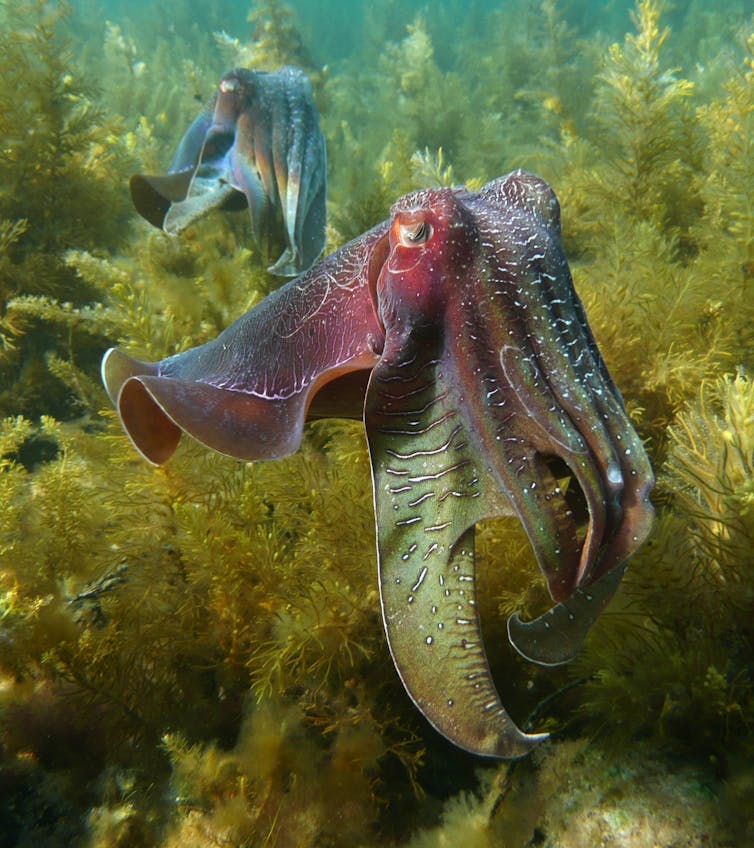 Giant Australian cuttlefish can change the colour and texture of their skin.
David Wiltshire, Author provided
Giant Australian cuttlefish can change the colour and texture of their skin.
David Wiltshire, Author provided
Read more: The science and art of reef restoration
But this population of cuttlefish dropped in abundance from an estimated 150,000 animals in the late 1990s to only 13,492 in 2013.
Although counts in recent years suggest the creatures have recovered, my research aims to determine what sorts of factors influence this very unique cuttlefish population. This may allow us to better manage and protect the species – important not just for science, but also for the local environment and economy.
Rockstars of the sea
Every time I head to the Point Lowly coastline and dive with the giant Australian cuttlefish I’m amazed and excited by their antics.
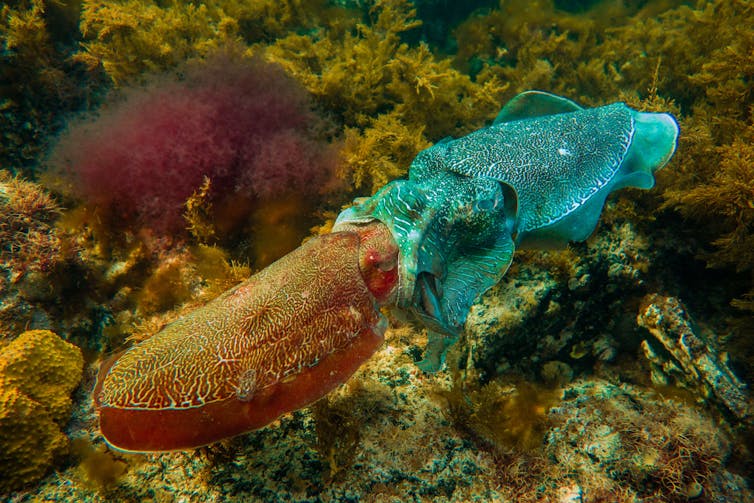 Giant Australian cuttlefish in an intimate embrace.
Matt McMillan, Author provided
Giant Australian cuttlefish in an intimate embrace.
Matt McMillan, Author provided
The name “giant” is perhaps a misnomer. Giant Australian cuttlefish only ever reach about one metre in size. Most animals are much smaller, especially in South Australia.
Cephalopods have been described as rockstars of the sea for their “live fast, die young” life history strategy – they grow rapidly, reproduce early and die following reproduction. Giant Australian cuttlefish live for 1-2 years.
Although they are found in waters across southern Australia, giant Australian cuttlefish live in distinct populations that do not interact. We know from genetic studies that those breeding along that small area of Upper Spencer Gulf coastline are restricted to an area north from a line across the gulf from Wallaroo to Arno Bay (around 6,500 km²).
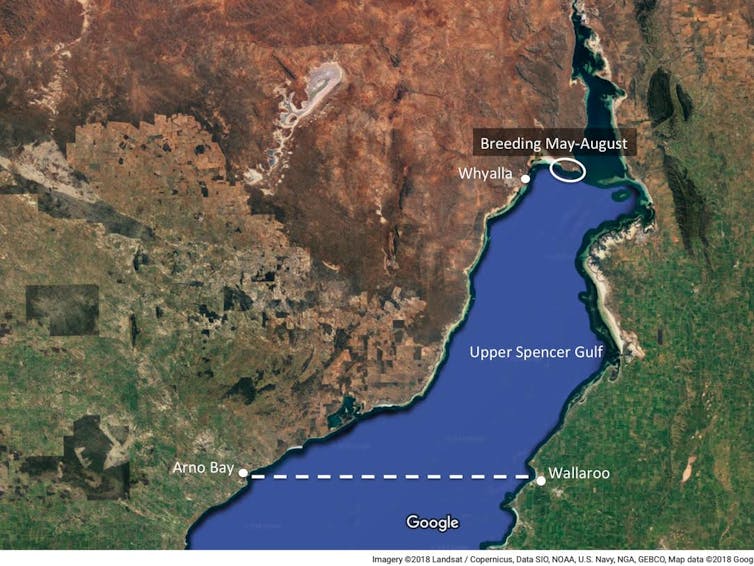 The most northern waters of Upper Spencer Gulf in South Australia host a unique population of giant Australian cuttlefish.
Ellen Rochelmeyer (using Google Maps), CC BY-NC-ND
The most northern waters of Upper Spencer Gulf in South Australia host a unique population of giant Australian cuttlefish.
Ellen Rochelmeyer (using Google Maps), CC BY-NC-ND
Outside the breeding season of May to August they are distributed throughout this northern region. Come May they start to move towards a narrow 8km stretch of rocky coastline. At their peak you see literally one cuttlefish per square metre. It’s the sheer numbers that are impressive!
They come solely for one purpose over winter – to find mates to reproduce.
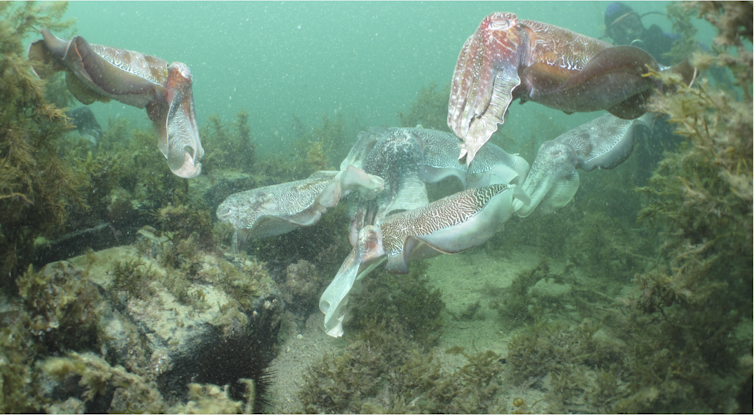 Cuttlefish gather to breed from May-August each year.
Tim Rogers, Author provided
Cuttlefish gather to breed from May-August each year.
Tim Rogers, Author provided
Sudden drop in numbers
Around the late 1990s, the cuttlefish breeding aggregation in the Upper Spencer Gulf began to be targeted by fishers. Since then, a number of restrictions on taking cuttlefish and other cephalopods from these waters have been in place.
Around that time, a program of research through the University of Adelaide and SARDI Aquatic Sciences also began. Estimates of abundance and biomass of the breeding aggregation population suggested around 150,000 cuttlefish bred in the Upper Spencer Gulf. The surveys stopped after a few years.
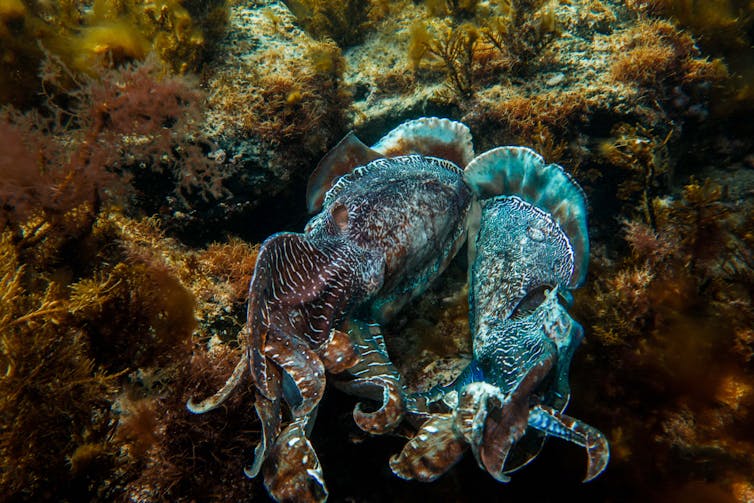 Numbers of giant Australian cuttlefish in the Upper Spencer Gulf fell dramatically between the late 1990s and 2013.
Matt McMillan, Author provided
Numbers of giant Australian cuttlefish in the Upper Spencer Gulf fell dramatically between the late 1990s and 2013.
Matt McMillan, Author provided
Then in 2005 anecdotal reports from SCUBA divers suggested cuttlefish were less abundant. A survey at that time and continual data collected since 2008 confirmed that numbers had dropped. In 2013 less than 15,000 individuals were estimated on the breeding aggregation.
Significant resources were put towards studying the cuttlefish to determine what might be causing such a decline. Changes in water temperature and salinity may be involved.
Read more: Three reasons why it’s a bad idea to ramp up Adelaide's desalination plant
We looked at data for other cephalopods over a similar time frame, and found no such decline. In fact, over the last 60 years many different types of cephalopod have been increasing in abundance – it’s not yet clear why.
The low numbers of 2013 seem to be unique to the giant Australian cuttlefish on the Upper Spencer Gulf.
Since this time there has been a recovery in this population, with numbers bouncing back towards their late 1990s levels.
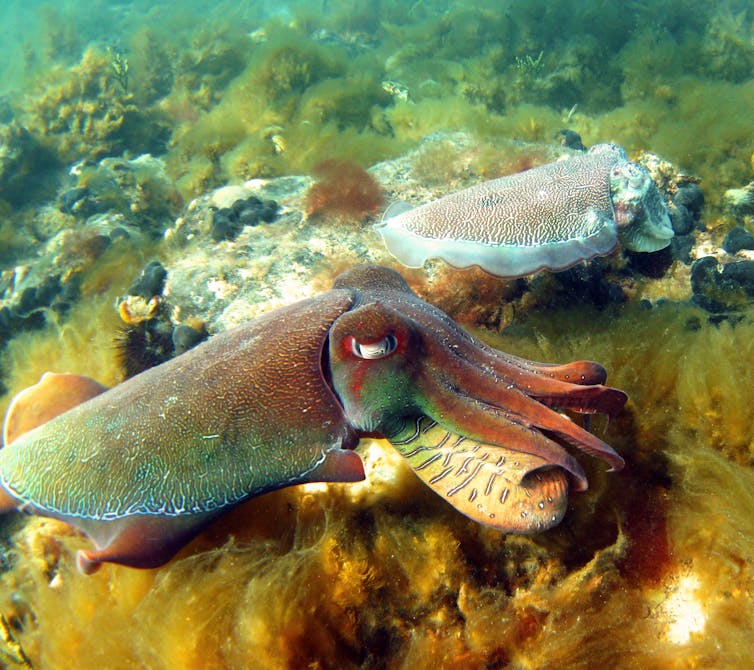 Some giant Australian cuttlefish reach one metre in length - but most are smaller.
Nick Payne, Author provided
Some giant Australian cuttlefish reach one metre in length - but most are smaller.
Nick Payne, Author provided
How cuttlefish breed
We know that cuttlefish come to this breeding aggregation to mate using a range of amazing strategies and behaviours – for example, small males impersonate females to avoid detection by larger males and gain access “under cover”.
Read more: Did they mean to do that? Accident and intent in an octopuses' garden
Because the population on the breeding aggregation is skewed towards males (an average o four to one), females have some choice over who they mate with.
After mating takes place, females deposit eggs on the underside of rocks.
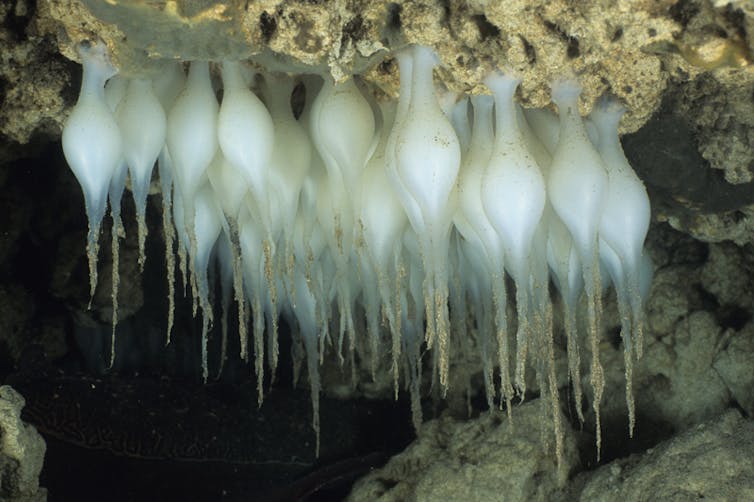 Cuttlefish eggs deposited on the underside of rocks.
Fred Bavendam, Author provided
Cuttlefish eggs deposited on the underside of rocks.
Fred Bavendam, Author provided
Cuttlefish eggs take three to five months to develop, hatching from mid-September through to early November. They emerge as miniature adults about the size of your thumbnail.
Baby cuttlefish disperse within the Upper Spencer Gulf with an even sex ratio.
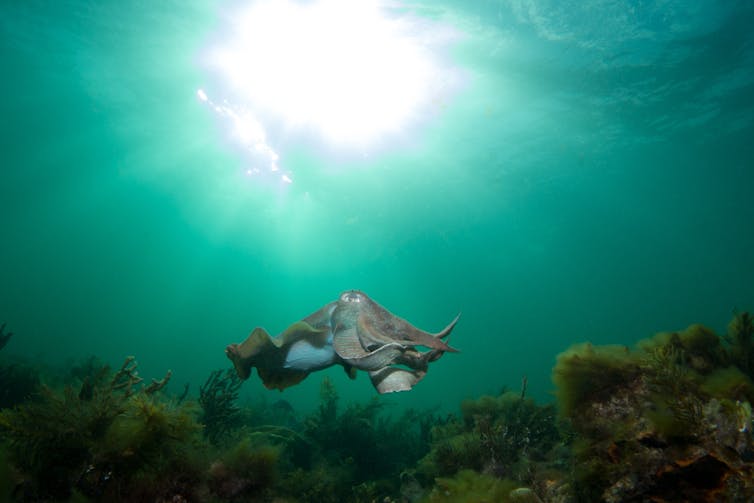 Cuttlefish gather in only a few metres of water in the Upper Spencer Gulf.
Matt McMillan, Author provided
Cuttlefish gather in only a few metres of water in the Upper Spencer Gulf.
Matt McMillan, Author provided
To work out why there was a difference in sex ratio between the broader region (1 male:1 female) and the breeding aggregation (4 males:1 female), we tagged male and female cuttlefish using trackable acoustic markers. We discovered that males spend around four times the length of time on the breeding aggregation compared to females, and that individuals are not present for the whole breeding season.
So the breeding aggregation is likely larger in size than fixed time frame counting estimates allow us to measure.
Positive influence on local economy
Although the apparently low population size in 2013 caused great concern, we are now cautiously optimistic for our giant Australian cuttlefish in Upper Spencer Gulf.
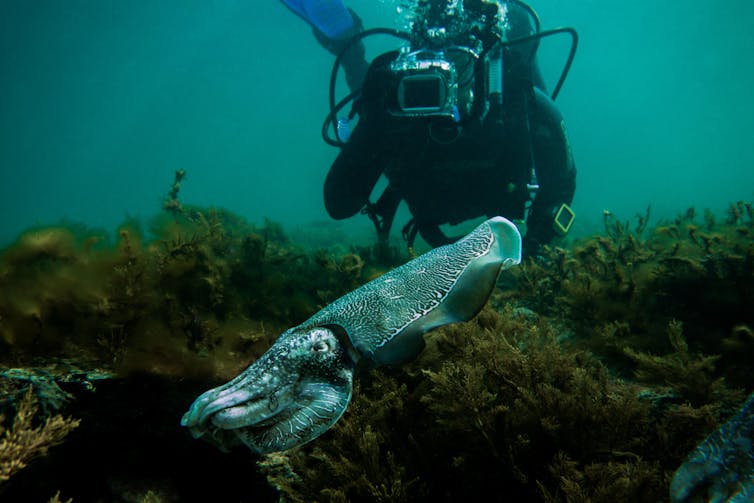 There’s something behind you!
Matt McMillan, Author provided
There’s something behind you!
Matt McMillan, Author provided
These creatures attract tourists from around the world, who come and snorkel or SCUBA dive on a unique breeding aggregation. This in turn injects money into the local economy and diversifies business in the region.
The cuttlefish are just one “user” of our shared marine environment along with the other activities and industries of South Australia.
This article is based on a presentation delivered by Bronwyn Gillanders at the South Australian Museum as part of the Sprigg Lecture Series.
Authors: Bronwyn GIllanders, Professor , University of Adelaide
Read more http://theconversation.com/why-were-watching-the-giant-australian-cuttlefish-101183





